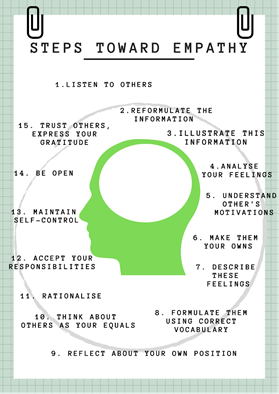Content begins here
Contenido de la página principal
Pulsa para colapsar
Empathy
Introduction
Empathy or social intelligence is the capacity to connect with people: learn how to put yourself in the place of the other, listen to people trying to think how they are feeling in a given moment, understand why they are behaving the way they do. For the purpose of, after understanding someone's emotions, acting consequently taking into account other feelings and trying to prevent or overcome a conflictual situation.
From the minute we wake up until we go to sleep, we must deal with all manner of relationships: family, friends, work colleagues… This is part of our daily routine but, although we know that humans are social animals, not everyone knows how to manage well situations related to the social field.
Empathy is something that is natural to you and in some cases, you need to learn to become it either on your own or by someone guiding you. One thing that is clear is that there is always room for improvement and for bettering ourselves.
Once this lesson is completed and approved, learners will be able to:
1. Know how many skills they have related to empathy.
2. How to improve the level of empathy.
In this lesson we will learn how to increase our level of empathy and understanding of others, so to better the nature of our social interrelationships.
Understanding empathy: are you an empathetic person?
The first step to being able to develop your empathy is to know what characteristics an empathic person has. These are some of them:
1. Sensitivity and feeling what others feel: empathic people are sensitive and understand the feelings of others.
2. Good listeners: they listen actively, that is, they don't just listen to what people are saying. They focus on what the other person is telling them, analyse why the person feels the way they do and give responses accordingly.
3. They are not extremists: they do not believe that everything is black or white, they know that there is a nice range of grey in between. For example, when a conflict arises, they do not position themselves easily, they try to find intermediary answers.
4. They are respectful and tolerant: empathic people respect the decisions of others, even if they do not make the same decisions.
5. They understand non-verbal communication: they look at both verbal and non-verbal language. They attend to gestures, looks, inflexions and tones of the voice, etc. With what they manage not only to understand the verbal message but to extract the emotional message that the non-verbal language demonstrates.
6. They believe in the goodness of people: when they meet someone, even if that person has a “bad reputation”, they assume that the person is good until they prove otherwise. They believe that people are good by nature.

7. They speak carefully: they try to be careful and to express themselves with tact while having the least negative impact on the other.
8. They understand that each person is different: they understand that each person has needs and that we are all different. They know how to treat each person according to their circumstances.
Learning to empathize: how to become an empathic person.
Once we know the main characteristics of an empathic person, we could move to study how we can be more emphatic, that is, how we can build on any of these characteristics that we lack.
1. Grow in self-knowledge:
To grow in empathy, and better understand the feelings of the people around us, we first must empathize with ourselves.
It is important to know how to recognize, understand and accept our feelings and to self-reflect.
To do this, take time to think about your emotions: what situations make you angry, make you sad, make you happy ...? Why do you react the way you react?
Self-knowledge will help you better understand the emotions of those around you.
2. Understand others:
While working on self-knowledge, we must ask ourselves what effects our behaviour has on the people around us:
• Evaluate the effects of your behaviour or your words, dare to think:
- What would I feel if someone behaved the way I am behaving?
- What would I feel if someone told me what I am saying?
- What consequences will this way of saying or doing things have: will it be good or bad for me in terms of my life project, will it be good or bad for others and for the good of society?
• Inspire confidence, behave with others with a positive and open attitude.
• Avoid prejudices, show yourself willing to know and understand those around you. Try to put aside your perspective on things and try to understand how others see the world.
• Ensure your gestures are welcoming. Avoid verbal and non-verbal displays of superiority, boredom, and tiredness in your interactions with others.
• Facilitates teamwork, avoids conflict, learns to give in gracefully.
• Show interest in the people around you.
• Be open to what they are concerned about and how they should feel emotionally at that moment in order to understand them better.
• Take care of what you say, where you say it, how you say it and to whom.
• Adapt your way of communicating to the level of authority of the person in front of you.

Conclusion
Empathy is essential to prosper in the world around us and to have successful relationships in all areas: family, social and work. Regarding the latter, we wanted to note that although science and technology have flourished greatly, and many jobs are being carried out by machines and robots, only man can provide the empathy and emotional intelligence necessary to work as a team, resolve conflicts and establish strong relationships built on trust.
Bibliography
www.nytimes.com/guides/year-of-living-better/how-to-be-more-empathetic
Video and PDF presentationPulsa para colapsar
The following video explains the content of this lesson and shows some examples:
Video T3.L1. Empathy
Here you have the content of the video in pdf in case you need to use it in your classroom:
Lesson contents in PDFPulsa para colapsar
Here you have the contents of the lesson in PDF:

